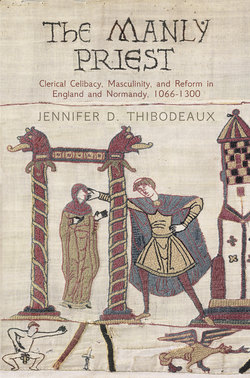The Manly Priest

Реклама. ООО «ЛитРес», ИНН: 7719571260.
Оглавление
Jennifer D. Thibodeaux. The Manly Priest
Отрывок из книги
The Manly Priest
Ruth Mazo Karras, Series Editor
.....
Appearance could profoundly affect behavior. Anselm’s great concern over masculine appearance found its way into the canons of Westminster in 1102. While four of the canons from this council concerned celibacy of the clergy, three others regulated appearance and other behavior. Canon 13 declared clerics should wear an appropriate tonsure, while canon 11 attempted to regulate wearing of brightly colored clothing, which was likely a safeguard against luxurious fabrics.63 Some scholars have noted the link between such fabrics, luxuria, and femininity. William of Malmesbury felt it necessary to offer the example of the saint Aldhelm, who warned his student against associating with prostitutes; in addition to the sexual danger they posed, prostitutes had a tendency to wear brightly colored clothing. The saint also believed that such luxurious clothing could “emasculate his mental vigour.”64 Not only could the male clerical body be effeminized through wearing certain fabrics, but so could the mind.
Other sources also point to the role that reforming bishops played in setting the standard for manly behavior and appearance, especially when secular men, kings, knights, and nobles, failed to maintain their manliness. Serlo, bishop of Sées, admonished King Henry I in 1105 at Carentan for his and his courtiers’ unkempt appearances. In particular, they were rebuked for wearing their hair in a “woman’s fashion”; instead, the bishop told them to “use your strength like men (virili robore perfrui debetis).” After admonishing the king and his men for having long beards reminiscent of “he-goats,” Serlo continued: “by growing their hair long they make themselves seem like imitators of women, and by womanly softness (mollicie) they lose their manly strength (virili fortitudine) and are led to sin.”65 The reformer deployed the language of hardness and softness to correspond with manliness and femininity. Bishop Serlo also pointed out the effeminacy present in the habit of wearing poulaines, shoes with curved tips: “The perverse sons of Belial grow the tresses of women on their heads, and deck their toes (pedum suorum) with the tails of scorpians, revealing themselves to be effeminates by their softness (molliciem femineos) and serpent-like by their scorpian stings.”66 Once Serlo’s speech was concluded, the king and his men were so inspired by his words that they stepped forward and willingly had their hair shorn by the bishop. The king was transformed by this gender reinforcement, as he then went on, as Orderic Vitalis narrates, and “wreaked vengeance manfully (viriliter) on the enemies of the Church of God.”67
.....